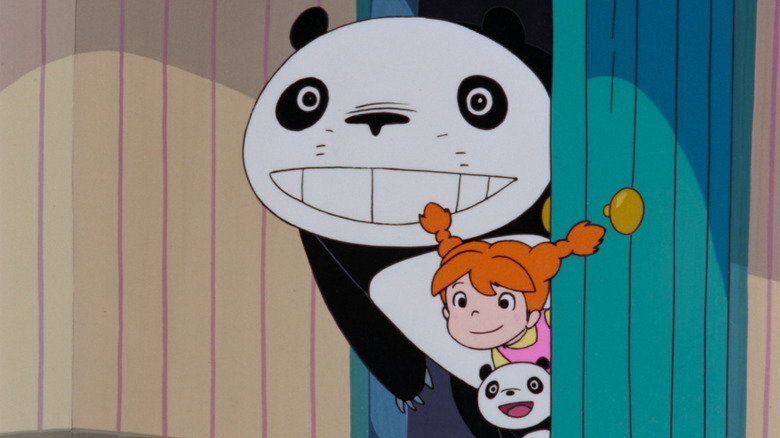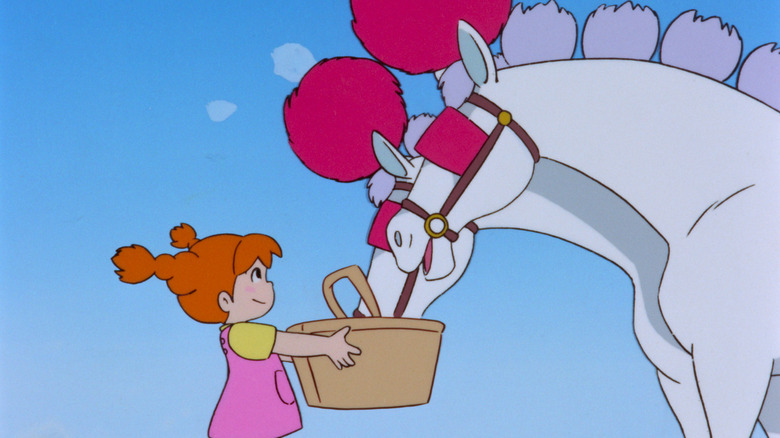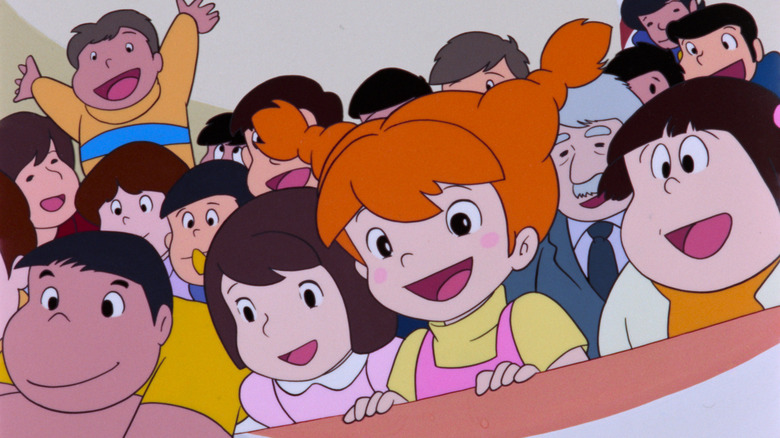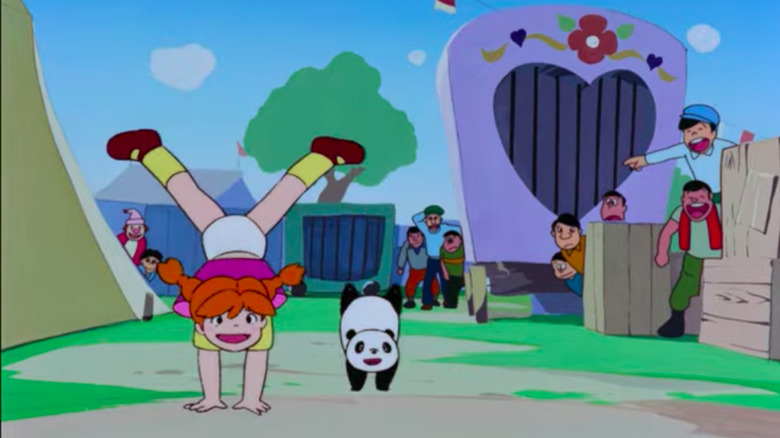Panda! Go, Panda!: Hayao Miyazaki And Isao Takahata's Landmark Anime Returns Restored After 50 Years
Pandas in anime are ripe for cuteness, comedy, and just plain bizarreness. Just look at the currently running manga and anime "Jujutsu Kaisen," where a large, talking anthropomorphic panda, casually combatting cursed spirits alongside human warriors, remains unexplained to the point that it baffles newcomers to the show's main campus setting. (There is an explanation but it dangles you in confusion and curiosity for most of its first season.)
Two legendary animators also toyed with the cutesy comic potential in pandas. If an animation fan recollects the pre-Ghibli canvas, they may think of Hayao Miyazaki's grander-scaled features like "Nausicaä of the Valley of the Wind" or "Lupin III: The Castle of Cagliostro." Recently, GKIDS is presenting the restored "Panda! Go Panda!" shorts, a pair of early-career collaborations between Miyazaki and his Ghibli co-founder Isao Takahata that started in 1972 in theaters. So let's splash into their animated pandemonium.
The panda craze that inspired it
When China donated a pair of giant pandas to Japan in September 1972, a panda craze broke out. The panda pairs, Lan Lan and Kang Kang, drew millions to Japan's Ueno Zoo. And thus their popularity helped greenlight a panda anime project by Tokyo Movie Shinsha (now known as TMS Entertainment).
In the concept written by Hayao Miyazaki and directed by Isao Takahata (with key animation directors Yasuo Ōtsuka, one of Miyazaki's mentors, and Yōichi Kotabe), the story centers around a young heroine, Mimiko, who lives cheerfully in a pastoral countryside despite having no mother and father. The first short begins with Mimiko's grandmother departing for a trip. Mimiko arrives home from the train station and is delighted to discover two talking pandas, a hulking papa-panda Papanda and his baby Panny Panda, both of whom were attracted to her cottage's proximity to a bamboo grove. Aghast that the girl has no guardians, Papanda offers to be her father figure while Mimiko offers to be Panny's parent. Of course, slice-of-life hijinks ensue when the zoo-catchers close in on them.
In the follow-up 1973 short "Panda! Go Panda!: Rainy Day Circus," the found family acquires a fourth member: a circus-fled tiger cub. They make a friendly acquaintance with the mother tiger. Later, a torrential storm breaks out so Mimiko, Papanda, and Panny find themselves rowing a boat in the biblically flooded landscape to rescue their tiger friends and the circus animals.
Creative ancestry
Ghibli fans will recognize the heroine: The plucky girl left to her own devices whether or not a parental figure is present. In 1971, Miyazaki conducted research for "Pippi Longstocking," visiting the Skansen Outdoor Museum and the Visby Castletown. The "Pipi" project didn't manifest beyond preparation but the research, speculatively landscape-related, for "Pippi" was utilized in "Panda! Go Panda!" (and the following "Heidi" project). Springing auburn twin twigy braids, Mimiko resembles the Pippi of Miyazaki's canceled "Pippi Longstocking." Miyazaki's affinity for classic children's literature is also on full display when the second short pays homage to "Goldilocks and the Three Bears" when Panny discovers that someone has eaten out of his tiny bowl, used his tiny towel, and, wait for it, slept on his tiny bed.
Keen-eyed animation historians will also spy the first short's connection to one of Miyazaki's influential films. Miyazaki shared in "Turning Point: 1997-2008" that he fell in love with Taiji Yabushita's 1958 film "Panda and the Magic Serpent" (known as "Hakujaden" in Japanese), credited as the first color Japanese animated feature and also bearing the contributions of Yasuo Ôtsuka. "Panda and the Magic Serpent" was one of those animated films that persuaded him that animation was the conduit for expressing "what is inside people's hearts" and hooked him into the field.
"Panda! Go Panda!" is inseparable from the comic and cutesy influences of "Panda and the Magic Serpent," which stars Disney-influenced critter sidekicks in the form of a panda and red panda. "Panda and the Magic Serpent" stages a brawl where the victor is a nigh-invulnerable bitty panda. A bullying swine and gang of animals (the White Pig mob) ambush the tiny Panda. But punching Panda does not penetrate or cause a bruise. Punch that panda and it's like punching titanium. To their chagrin, Panda unleashes its martial arts skills, strong-arms them into submission, and recruits them to help unite the movie's main couple.
The brawl homage in Takahata-Miyazaki's first panda short is cuter but still harrowing: a loose bulldog charges at Panny with open jaws. It's one of the few times mortal danger occurs in an antic-driven short. But then, sike! Chewing on Panny is like chewing on steel — Panny only flinches with a light "ow." With his single tiny arm, Panny lifts the bulldog and tosses the mutt away.
Creative descendants
With cuddly and huggable bellies, Papanda and Panny can be considered rotund models for Ghibli creatures like the plush-friendly Totoro of Hayao Miyazaki's "My Neighbor Totoro" or the paunchy-bellied tanuki of Isao Takahata's "Pom Poko."
The second short "Rainy Day Circus" bares more of the "Hayao Miyazaki's touch" as screenwriter, scene designer, layout artist, and key animator, so viewers can see his contributions resonating in his subsequent feature work. The circus chapter has a shot of outstretched hands reaching for Panny. Those outstretched hands would be echoed for a more uncanny and intimidating effect in "Nausicaä of the Valley of the Wind" when reproaching adults reach toward Nausicaa's bug friend in her childhood flashback scene.
In addition, Miyazaki shared about the "Rainy Day Circus" flooding climax that "[Takahata and I] shared a childhood attraction to floods." It appears Miyazaki rehearsed for that titanic flood in his 2008 "Ponyo," where his two young protagonists sail across the ocean to look for loved ones. The image of the circus train chugging through a flood may have influenced the train traveling over flooded plains in Miyazaki's 2001 "Spirited Away."
And one more connection: the mother tiger that clings to Panny in what seems like a precarious situation is reminiscent of Miyazaki's 1989 "Kiki's Delivery Service" where Kiki's cat Jiji is tucked in the paws of a house dog. Both situations turn out to be subversive where the larger animal is actually protecting the smaller one.
Above all else, the "Panda! Go Panda!" shorts can be best regarded as sandbox projects that exercised the elasticity and presence of Miyazaki and Takahata's animated styles. A year after the second "Panda" short in 1974, Miyazaki worked as scene designer and layout artist on the "Heidi" TV anime, alongside Takahata as director and Yōichi Kotabe (eventual key animator for "Nausicaä") as animation director. 12 years later, Studio Ghibli released its first feature "Laputa: Castle in the Sky," directed by Miyazaki, in 1986.
The newly restored "Panda! Go Panda!" opened in New York City on May 6 at the IFC Center and in Los Angeles on May 13, 2022 at the Laemmle Theatres in celebration of its 50th anniversary



